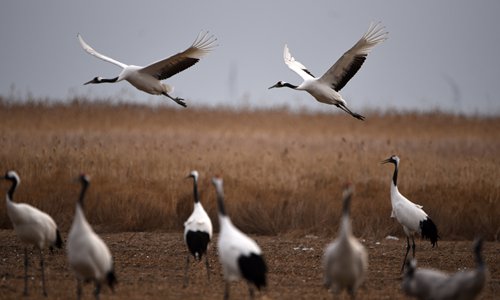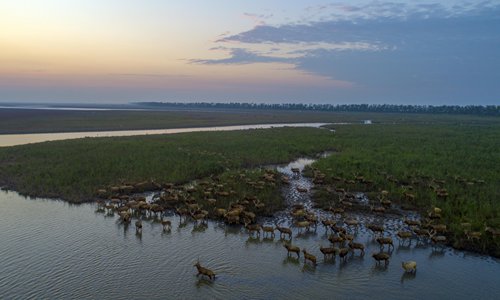HOME >> ARTS
Two new additions bring China’s number of World Heritage Sites to 55
By Chen Xi Source:Global Times Published: 2019/7/7 19:35:38


Migratory bird sanctuaries in Yancheng, Jiangsu Province Photo: IC

Migratory bird sanctuaries in Yancheng, Jiangsu Province Photo: IC
Friday and Saturday were full of surprises for Chinese, as two places in China were listed as UNESCO World Heritage sites.
The first, a World Natural Heritage, is composed of a series of migratory bird sanctuaries along the coast of the Yellow Sea in Yancheng, East China's Jiangsu Province.
The second, the Liangzhu Archaeological Site in Hangzhou, East China's Zhejiang Province, was listed as a World Cultural Heritage site.
Providing sanctuary
China began the application process for the bird sanctuaries in 2017. It only took two years to successfully complete the process.
"The reason the migratory bird sanctuary application was successful is because of the special geographical category of the area. It is the largest intertidal mudflat seashore in the world. The success of this application marks the beginning of China's world natural heritage from land to sea," Zhang Mingxiang, a professor at Beijing Forestry University's School of Nature Conservation, told the Global Times.
"The migratory bird sanctuaries are the central node of the East Asian-Australasian Flyway and many endangered species, especially threatened migratory birds including red-crowned cranes and flamingos, go there to hunt for food during the migration season," Wang Yamin, a professor at the Marine College at the Weihai branch of Shandong University, told the Global Times.
According to Wang, the birds usually take a month to finish their migration. At about 10 days into their migration, they must stop and find food in order to have the energy to continue their journey.
The migratory bird sanctuaries along the coast of the Yellow Sea of China posses a high degree of biodiversity, including nearly 280 species of fish and more than 500 species of invertebrates.
These provide a variety of food sources for millions of migratory birds, according to a report from the Xinhua News Agency.
Window to the past
Compared to the short turnaround for the World Natural Heritage's application, the Liangzhu application was far more complicated. The application team spent six years making their dream a reality.
"These two places cannot be compared, because a lot of archaeological work had to be carried out for the Liangzhu site, which means the application and assessment process takes a longer time," Tian Lin, a professor at the Beijing University of Civil Engineering and Architecture's School of Architecture and Urban Planning, told the Global Times.
"The site in Liangzhu is evidence of the existence of an early regional state in the lower reaches of the Yangtze River during the Late Neolithic period in China, which helps fill in the gaps in the history of the rice-cultivating civilizations of China and East Asia more than 5,000 years ago," Tian said, explaining that the site was one of the 20th century's most important archaeological discoveries in China.
Challenges ahead
With these two new additions, China now has 55 World Heritage sites, the highest number in the world. While these 37 cultural sites, 14 natural sites and four cultural/natural heritage sites are a source of pride, they also brings with them heavy responsibility.
"The successful application means greater responsibility and obligations," said Liu Yuzhu, head of China's National Cultural Heritage Administration, Xinhua News Agency reported.
"The application is just a form. We should not put too much emphasis on this form because protecting these places is much more important and is our future work," Zhang said.
Zhang emphasized that the new status of the migratory bird sanctuaries might boost local tourism industries but that this too poses a challenge as local governments will need to control tourist volume so as not to impact the birds' migration patterns.
Meanwhile, the sheer area that the Liangzhu Archaeological Site covers, some 14.3 square kilometers, makes protection a difficult issue to handle.
According to Tian, those working at the site are busy constructing protective shelters for the site and even reburying certain areas to protect them from exposure.
Plans are also underway to build a local museum for the storage and display of artifacts, so visitors can come and learn more about the history of the nation.
Newspaper headline: Pride and responsibility
Posted in: ART,CULTURE & LEISURE,ARTS FOCUS